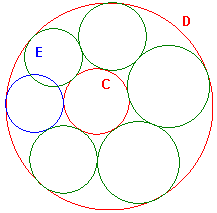


|  |
Steiner's Porism
| Suppose that a circle C lies inside circle D, and that circle E touches both of them. We can draw a sequence of circles, each touching C and D and the previous member of the sequence.
There are two possibilities,
either
Steiner's Porism
The proof is quite simple.
Note that C and D are non-intersecting i-lines. |  
|
|
Since the figure is symmetric about the common centre P, it is clear that, if starting with E gives a Steiner Chain, then starting with F will give the Steiner Chain obtained by rotation. Clearly, it will contain the same number of circles.
The CabriJava pane on the right shows a typical Steiner Chain
|
| Main inversive page |